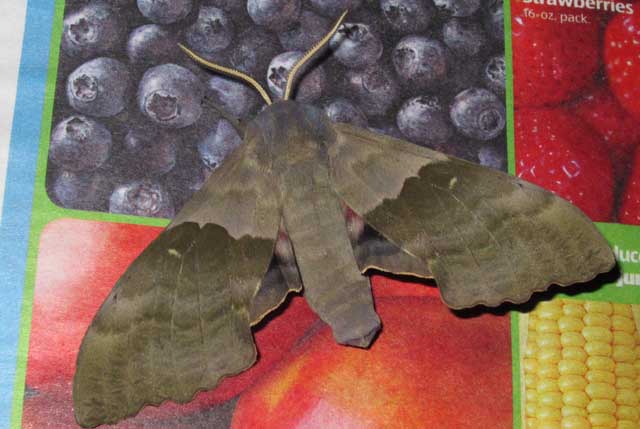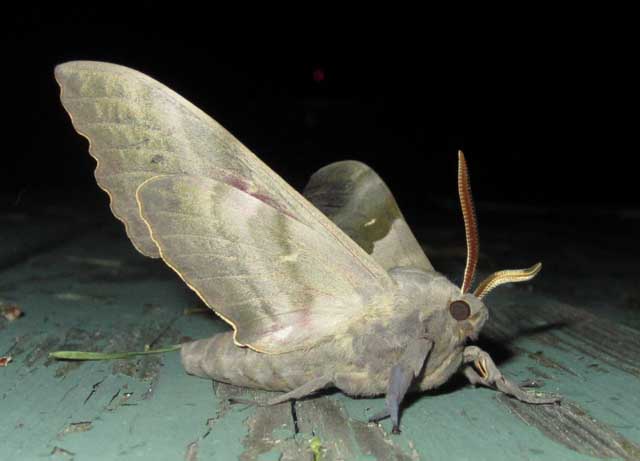Franklin County, northern New York
Sphingidae
Pachysphinx modesta, Saranac Lake, Franklin County, New York,
July 6, 2014, courtesy of Adirondack Bob.
|
|
Created/dedicated as per personal communication with Adirondack Bob (Pachysphinx modesta, July 6, 2014); July 9, 2014 Updated as per James P. Tuttle's The Hawk Moths of North America, July 9, 2014 Updated as per Butterflies and Moths of North America website, formerly USGS, July 9, 2014 |

Pachysphinx modesta, Saranac Lake, Franklin County, New York,
July 6, 2014, courtesy of Adirondack Bob.

Pachysphinx modesta, Saranac Lake, Franklin County, New York,
July 6, 2014, courtesy of Adirondack Bob.
Forty-six Sphingidae species are listed for New York on the BAMONA website. Not all of the species are reported or anticipated in Franklin County (only six are reported on BAMONA as of July 8, 2014). It is hoped that this checklist, with the thumbnails and notes, will help you quickly identify the moths you are likely to encounter.
A "WO" after the species name indicates that I have no confirmed reports of this species in Franklin County, but I (William Oehlke) expect that this moth is present.
A "BAMONA" indicates the moth is reported on the BAMONA website and/or in Lepidoptera of North America, #1. Distribution of Silkmoths (Saturniidae) and Hawkmoths (Sphingidae) of Eastern North America, an excellent little booklet available through Paul Opler.
Please help me develop this list with improved, documented accuracy by sending sightings (species, date, location), preferably with an electronic image, via email to Bill Oehlke.
Visit New York Catocala: Underwing Moths.
Sphinginae subfamily
Smerinthini Tribe:
Macroglossinae subfamilyDilophonotini tribe:
Visit Hemaris comparison to distinguish the following four species.
Philampelini tribe:
Macroglossini tribe:
|
Enjoy some of nature's wonderments, giant silk moth cocoons. These cocoons are for sale winter and fall. Beautiful Saturniidae moths will emerge the following spring and summer. Read Actias luna rearing article. Additional online help available.
Eggs of many North American species are offered during the spring and summer. Occasionally summer Actias luna and summer Antheraea polyphemus cocoons are available. Shipping to US destinations is done from with in the US.
Use your browser "Back" button to return to the previous page.
This page is brought to you by Bill Oehlke and the WLSS. Pages are on space rented from Bizland. If you would like to become a "Patron of the Sphingidae Site", contact Bill.
Please send sightings/images to Bill. I will do my best to respond to requests for identification help.
 Show appreciation for this site by clicking on flashing butterfly to the left. The link will take you to a page with links to many insect sites. |
I very much appreciate all the many images that have been sent to me, or of which I have been granted permission to copy and post from other websites. All images on this site remain the property of respective photographers.
If you would like to contribute to the maintenance of this website by sending a contribution to
Bill Oehlke
Box 476
155 Peardon Road
Montague, Prince Edward Island, C0A1R0
Canada
your donation would be much appreciated and would be used for
1) paying for webspace rental;
2) paying for computer maintenance and software upgrades;
3) purchases of additional text reference material (journals and books) in anticipation of expanding the site to a worldwide Sphingidae site;
4) helping to pay my daughter's tuition ( completed Spring 2013); with anything left over going to humanitarian aid.
If you are mailing a check from USA, please use $0.85 postage ($1.15 is 2014 rate). Donations can also be made through Paypal via the button below.